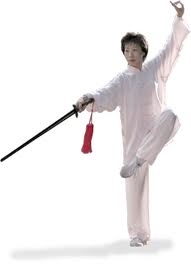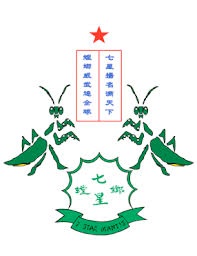training curriculum...


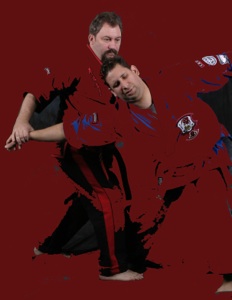
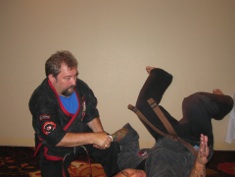
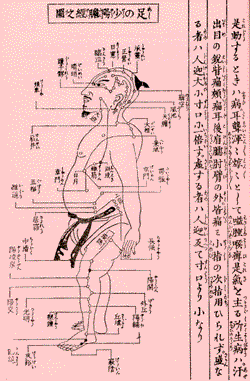
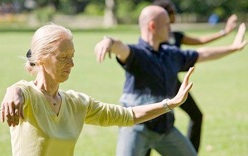
We are currently offering 9 main training areas at WSMAA. For information regarding private lessons, public seminars and onsite corporate classes, please contact us at info@wsmaa.com.
Gentle and rhythmic movements based on cosmology and patterned after the movement of the outer universe. The human body is a miniature universe; this system of upright, graceful movements aims to guide an individual's microcosmic energy network in a manner that exactly follows cosmic law. Tai Chi movements influence and benefit all systems of the body, in particular the digestive, respiratory, endocrine and central nervous system. Through daily Tai Chi practice, the body's flexibility and coordination are enhanced and one is spontaneously in tune with the energies and rhythms of the universe. This brings about a heightened sense of happiness, peace and a natural vitality to one's life. Click on the Yin Yang symbol to learn more about Wu Shen Pai Tai Chi Chu’an as practiced at Warrior Spirit Martial Arts Academy.
Qi Gong
Disciplined, upright body postures and movements in combination with visualization and breathing techniques. It is an effective way to understand the energy dynamics within our body and how these energies interact with all the energies that surround us in our daily lives. Learn how to focus on your energy center, release blocked passageways and balance emotional highs and lows. Practicing Qi Gong regularly brings the energy within the body's inner universe in harmony with the outer universe. Effective Qi circulation slows down the degeneration of the body, prolongs life and promotes spiritual growth.
Tai Chi Sword
Tai Chi Sword is one of the armed exercises of the Tai Chi School. It is a soft style and is based on the principles of Tai Chi Chuan. This style developed around 300 years ago. Movements are smooth, gentle and continuous. Therefore, Tai Chi Sword, as a traditional physical exercise, is also well received as a favorable way of protecting fragile health and recovering strength.
This course teaches an explosive, unique, powerful and effective art which is ideally suited for self defense training for all ages. Follow this link to learn more about the training aspects of Wu Shen Pai Chu’an Fa Kung Fu. Wu Shen Pai is more than a martial art system of self-defense. Wu Shen Pai involves a series of vigorous exercises which, when practiced diligently, improve physical and mental stamina as well as coordination. It is a method of training that builds core fitness for life. The term “Wu Shen Pai” means “martial spirit family” while "Kung Fu" means "hard work", exactly what a student of Wu Shen Pai Chu’an Fa Kung Fu is expected to endure diligently and faithfully in order to achieve mental and physical discipline.
Northern 7 Star Praying Mantis
This explosive and dynamic system of Kung Fu is offered separately and as a part of our Wu Shen Pai Chu’an Fa Curriculum! We are affiliated with Realistic Fighting Systems and Sigung Tony Puyot’s Traditional Martial Arts Association. Follow the link above to learn more about our historic Seven Star Praying Mantis Lineage!
Kanda Ha Kamishin Ryu Aiki Jiu Jitsu
Kamishin-Ryu is traditional Japanese Ryu of Jiu Jitsu currently headed by Sok Don Phillip. He inherited the Art from Soke Al Church, the modern head of family. Nippon Kobudo Kamishin Ryu Jujitsu (Japanese Ancient Martial Way Devine Heart Style) is considered a classical style that is rich in Japanese tradition. Kamishin Ryu Jujitsu is a consolidation of several forms of Japanese Jujitsu including the Shinyo Ryu, Takaguchi Ryu, Daiyoshin Ryu, Enrei Ryu, and Hakko Ryu. It is an Aiki-Jitsu form which employs circular motion to immobilize the attacker. It is Aiki-Jitsu, which employs Ki extension and redirection much as the modern Aikido art. Kamishin Ryu requires the mastery of the basic and advanced Kuzushi-waza (Off-Balancing Techniques) together with the use of the dynamic sphere employing circular motion to divert and/or lead the attacker to overextend the Ki or force of the attack.
Chin Na
The Chinese martial art of seizing and controlling an attacker. It is the root of the Japanese arts of Jiujitsu and Aikido. Chin Na techniques involve targeting and attacking pressure points and locking joints to render an attacker helpless. These techniques can be used for attacking in hard martial arts, but in this course students will learn the self-defense application only--the way of peace. The finer and deeper aspects of the human anatomy will be taught and students will also learn through a partner to develop a high degree of sensitivity and control in the physical movements and concentration. Chin Na is but one aspect of the Wu Shen Pai system.
Traditional Lion Dance
In Chinese communities around the world, the lion is believed to be a good omen which scares away evil spirits and ushers in good fortune, thus no festivity or grand opening is complete without the clashing cymbals, the gong and the rhythmic drum beats which herald the traditional Lion Dance! In this unique and rarely taught course, the students will learn an energizing and fun-filled blend of creativity and skill. This course will enhance teamwork and coordination while building stamina and physical fitness. Learn powerful movements based on Kung Fu skills as well as traditional Chinese instruments that come together to form the rhythmic drama of the traditional Chinese Lion Dance.
Meditation
Meditation restores the mind to its original state of pure integrity; enjoy the simplicity of the pure mind through this form of still meditation. Deepen your understanding of the principle of Wu Wei or "non-doing" by learning how to properly practice these ancient techniques. Experience how centering the mind enhances the clarity and focus in your daily interactions and activities.
Traditional Chinese Medicine
In order to become a balanced martial artist, it is important to be able to heal training injuries and minimize damage to our opponents as well as harm those who attack us. To this end, Wu Shen Pai Chu’an Fa teaches the traditional Chinese Healing Arts of Accupuncture, Accupressure, Herbal Medicines, and Bone Setting. The various sub-disciplines of the Traditional Chinese Healing Arts are taught in conjunction with advanced training in Wu Shen Pai Chu’an Fa Gung Fu.
Traditional Pai Lum Tao Gung Fu
Sigung Jones studies with Grandmaster Glenn Wilson, the lineage holder of Pai Lum Tao. Wu Shen Pai is considered a sub-style of the Pai Lum Tao system, which Grandmaster Jones heads. Thus, Pai Lum forms, Weapon forms, and self defense techniques also form part of the repertoire of knowledge which is Wu Shen Pai, or the Warrior Spirit Family. Sigung Jones is a 4th Higher Level in the art of Pai Lum.
Kajukenbo (Carlson Method)
Sigung Jones studies with Grandmaster Ron Carlson, the founder of the Carlson Method of Kajukenbo. He holds 8th Dan in Kajukenbo in that lineage. Wu Shen Pai employs soft style forms forms within the Carlson Method which are influenced by the Chu’an Fa division of Kajukenbo. Grandmaster Carlson’s self defense methods and theories form an integral part of the Wu Shen Pai system. The Carlson method is part of the Ordenez Ohana or family within Kajukenbo.
Teaching Syllabus
Grading Syllabus
The syllabus expresses the principles of Wu Shen Pai Chu’an Fa Gung Fu. It is designed to impart the skills of our system in an effective, concise, progressive, and systematic manner. The teaching syllabus conveys the teachings and refinements of the founder and other masters who have shaped and developed this particular system of knowledge. Grading occurs monthly, higher level grading occurs quarterly and Black Sash testing occurs yearly. This allows students the opportunity to demonstrate their level of attainment, their mastery of their current level and their readiness to progress to the next level of study.
Fundamental Basics
Wu Shen Pai Chu’an Fa Gung Fu emphasises the acquisition of high levels of physical skill and the perfection of technique. Physical strength does inform the practice of our system, but we also place importance upon improving balance, flexibility, endurance and concentration. Speed is crucial to the attainment of power. Speed is power.
We begin by teaching students stances, how to stand and position their bodies in a relaxed yet centered way delivering the stability and impetus necessary for the exercise of effective punching and kicking techniques. The shifting of body weight, hip rotation, and footwork, are all combined with upper body techniques to realize a holistic bodily response when fending off an attacker. In short, your body is behind every blow struck. The blocking of an attack as well as the use short and long-range self-defense techniques such as joint-locks and throws are also taught as elements of the Wu Shen Pai martial gung fu vocabulary.
Self Defense Techniques
Various hand and leg techniques are combined into a sequence and taught in a manner that allows the student to concentrate upon and isolate aspects that are crucial to their perfectibility. The teaching of self defense techniques involves exercising defensive and attacking sequences in response to a standardized attack. Evasion-the judgement of distance and timing, of both defense and the initiation of a rapid counter-attack, becomes a critical element of the student’s study.
Forms and Training Sets
These are pre-arranged sequences and choreographed techniques that are used to help students perfect a series of individual techniques and stances, to develop ‘flow’ between movements, and to understand the shifting energies and rhythms underpinning the delivery of fighting techniques. Forms comprise the art of the system’s practice. When performed well, their aesthetics are visually beautiful and compelling to watch. They are subtle and nuanced yet strong and physically demanding. Forms continually offer new insights. They are effective ‘vehicles’ for sustained investigation and learning. Drills are adapted from the forms which allow the student the opportunity of further honing the skills they have learned in an applied situation for enhanced effectiveness and realism.
Freestyle Sparring
Students learn how to apply the techniques they have learned by sparring together in a restricted ‘combat’ situation, practiced and monitored within a safe classroom environment. The intention is to further develop technique, response and control when faced with the unpredictability of a real-time opponent. Sparring teaches the physical skills of maintenance of proper distance, maneuvering, and accuracy. It teaches the mental skills of honing your indomitable spirit, courage, and discipline.
Extended Syllabus
The Wu Shen Pai Chu’an Fa Gung Fu system includes many other elements of traditional martial arts training. At the discretion of their Sifu, students are given access to a broad range of experiences so that they may specialize at a later and suitably advanced stage of their training. The extended syllabus is taught within the framework of regular classes, special daylong workshops and periodic longer training trips.
Weapons Training
Once students have learned to master basic hand and leg techniques they are also taught forms associated with Classical Chinese weapon types. This teaching underlines the importance of preserving traditional Chinese martial arts practice. Weapons training includes the Staff, Spear, Double Ended Spear, the Double Iron Ruler, Broadsword, Double Broadswords, Cane, Hook Swords, Kwan Dao, Pu Dao, Single Hook Sword, Three Sectional Staff, Whip Chain, Meteor Hammer, the Trident, The Monk’s Spade, and the Fan among others. The value in the cultural historicity of these weapons is further affirmed by what they can offer a contemporary practitioner- the open hand techniques, stances, movement and shifting they compel in order to be effective all have strong implications, and offer insight and benefit into the overall exercise of a martial arts discipline. Weapons also serve a valuable function as a method of training and conditioning of the body.
Animal Styles of Training
Contemplation and reflection upon the natural world has been key to many traditional Chinese arts and disciplines. Accordingly, for centuries, Shaolin monks have reflected upon how different animals have defended themselves and responded to attack. The resultant interpretative fighting styles have tested comprehension of the embodied animal metaphors and have been distilled into unique forms such as the crane, snake, monkey and tiger, each with their own distinctive mode of attack and defence. All are taught as part of advanced Wu Shen Pai training. The Seven Star and Eight Step form of Northern Praying Mantis Gung Fu is taught as a part of advanced Wu Shen Pai Training.
Qi Gong
Qigong, chi kung, or chi gung literally means "Life Energy Cultivation" and it is a practice of aligning breath, movement, and awareness for exercise, healing, and meditation. With roots in Chinese medicine, martial arts, and philosophy, qigong is traditionally viewed as a practice to cultivate and balance qi (chi) or what has been translated as "intrinsic life energy". Typically a qigong practice involves rhythmic breathing coordinated with slow stylized repetition of fluid movement, a calm mindful state, and visualization of guiding qi through the body. Qigong is practiced in all levels of the Wu Shen Pai Chu’an Fa Gung Fu syllabus.



